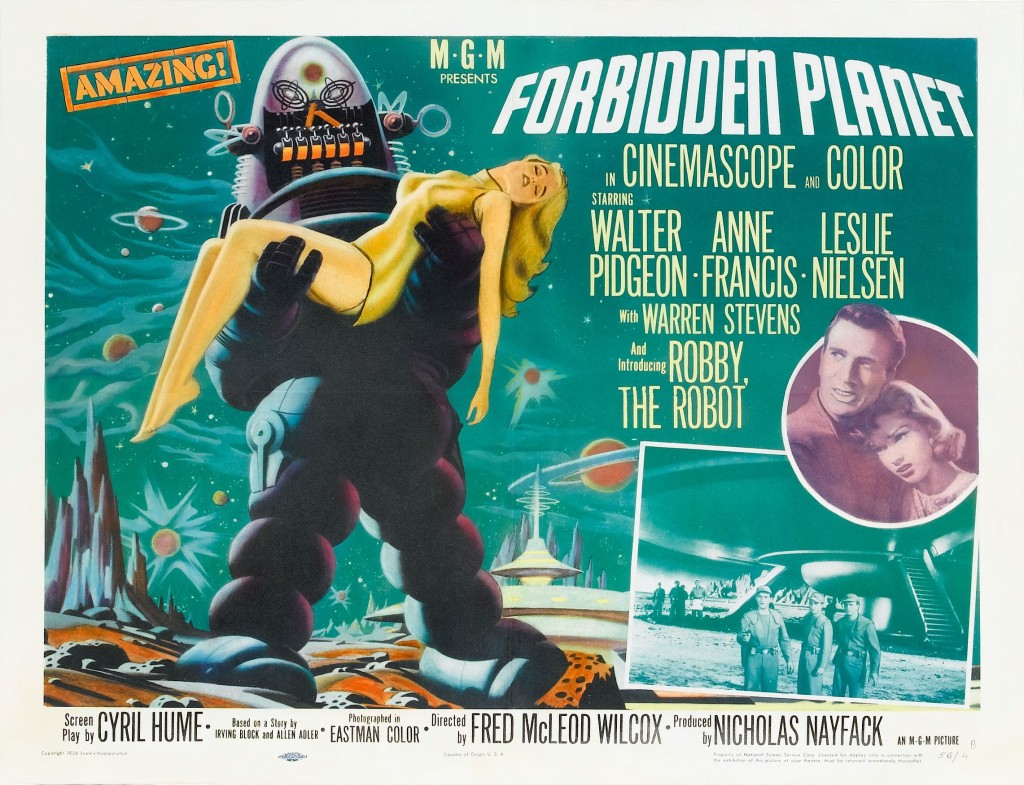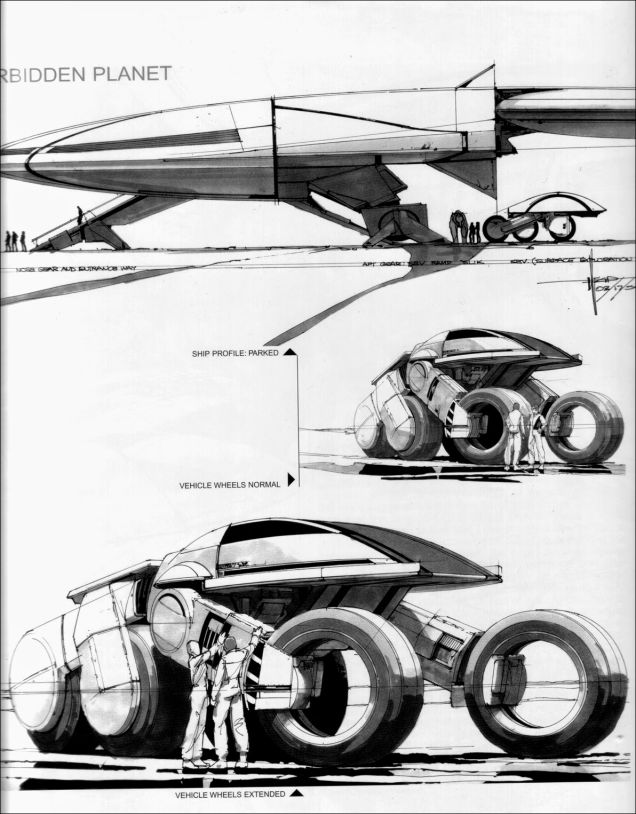Genre: Sci-fi
Premise: When a distant civilization calls out to earth, humanity sends a ship to the planet to make contact. But all they find is a deserted world.
About: The original 1956 film is a classic and the first film to portray humans travelling together in a space ship. As recently as six years ago, James Cameron was intrigued with the possibility of making Forbidden Planet. Furthermore, the writer, J. Michael Straczynski, in typical Hollywood fashion, wanted to make a trilogy out of the property. While the project died not long after, we must remember that nothing in the movie business ever really dies. I’m sure the project will rise again.
Writer: J. Michael Straczynski
Details: 122 pages
Confession time. I’ve never seen Forbidden Planet. A lot of people will tell you that the 1950s film “holds up,” but come on. It’s 1950s special effects with cheesy 1950s acting. You might as well take out the sound and add dialogue cards.
Now from what I understand, in the original film, this ship the “Bellerophon” went to this mysterious planet but disappeared, and so earth sent a second ship to go figure out what happened to the Bellerophon. Well, with Straczynski turning this into a trilogy, he’s decided to follow the Bellerophon’s journey first, and that’s what this draft focuses on. I didn’t find out about the trilogy plans until after I read the screenplay, but it makes a whole lot of sense now, for reasons I’ll get to a bit. But first, a summary of the story…
The plot is pretty straight-forward. Aliens send earth a signal, along with instructions to build a ship and come visit them. There’s one small glitch though. The end of the signal cuts out, indicating that something may have happened while sending it.
Humanity builds a big giant ship, headed up by Captain Thomas Stearn. There’s like a 70 man crew, but the other two important players are Dr. Edward Morbius, a linguistics expert, and his wife (in title only), Diana Morbius. We sense a wee bit of tension between these three as Diana may or may not be secretly involved with Stearn.
So anyway, they fly to this planet, Altair-4, and the entire planet is one big city. But an abandoned city. There isn’t a single life-form around. However, when we see them leave the ship, we zoom in to notice little nano-robots entering their mouths as they breathe.
They then find an old museum where a robot named RBI (who they nickname “Robbie”) explains what he knows about the planet. Unfortunately, he’s been shut down for 800 years, so he can’t tell them why no one’s around.
Eventually, our emerging villain, Morbius, goes AWOL, and due to some connection with the nano-robots inside of him and this fully automated city, starts to actually control the planet, and quickly works to prevent the Ballerophon from leaving. Stearn will have to figure out how to stop Morbius if he’s going to save his crew, a task that’s looking less and less likely by the minute.
So when I started reading this, I noticed something pretty quickly. It was a cool idea. I was into it. But the story started to drag. Despite actually getting to the planet by page 30, our crew was still exploring it on page 70.
There’s a period after your characters get to the “problem spot” in your story where they start looking around and trying to figure out what’s going on. Blake Snyder of Save the Cat fame liked to call this the “Fun and Games” section, but that doesn’t really apply outside of comedies and family fare. Instead, I like to call this the “Discovery” section. This is where characters try to “discover” what’s going on in the environment they’ve been sent to.
“Discovery” should really only happen for about 15 pages (which is the same amount of time, I believe, Blake Snyder gives for his “Fun and Games” section). After that, the audience/reader starts to get restless and wants change. Imagine, for instance, in Alien, if our excavation crew went down on the Alien planet for 40 pages as opposed to 15. We’d get bored, right? We need to get to the next phase of the story, which is to bring the alien back to the ship.
But even if you’re required to stay in the location with your characters, you need to start introducing some heavier plot developments than simply finding a robot and chatting with him (as was the case here). I know there are a lot of Prometheus haters out there, but you’ll notice that the Discovery phase didn’t go on for long before a series of intense plot developments started to occur.
And that was my big problem with Forbidden Planet. It was that classic issue where you can sense that the writer is spreading his story out. He doesn’t have enough meat to cook with. At first I was confused about this. I knew Straczynski was a good writer. So why was he doing this?
Then I read about the planned trilogy and it all made sense. And hence, we have one of the biggest writing problems plaguing Hollywood today. It’s hard enough to come up with a great two hour story. But if you tell the writer, before he writes a word, that he actually has to write a SIX hour story, this is what you’re going to get. Long-drawn out plots with not enough happening.
This is the same thing that happened with the Hobbit trilogy. I remember watching the second Hobbit movie, and there came a point in the middle of the film with this big water-rafting barrel floating set-piece – and I thought to myself, “Yeah, this is a big set-piece but where are the stakes? Why is this important for the story?” It was empty because you could tell the writers were trying to cover the fact that they didn’t have a lot of story to begin with. The strategy, then, was to distract you with a big fat set-piece.
The solution to this problem is to always think of your script as a single script, even if you do plan to continue it with additional movies. Try to make it the best actual story on its own.
But there’s a bigger lesson here for screenwriters. And that’s to keep your story moving quickly. One thing I’ve found with young writers is that whatever you think is “fast-paced” is actually a lot slower on the page. It takes years and years for writers to actually understand how fast their story is coming across on the page.
So focus on moving the story along faster than you believe you have to. And that means introducing major plot points that push the story in new directions (a dangerous face-hugging alien on one of your characters) rather than small plot advancements that only have a minor effect on the story (finding a museum on your mysterious new planet).
Or, if you want me to put it simply: More shit needs to happen.
It’s kind of funny that we’re discussing this in the wake of a review about scripts that are ‘too complex.” But that’s not really what we’re talking about here. Complexity has little to do with writing bigger plot points that happen more frequently, which was the problem with Forbidden Planet. This script needed more meat. Maybe in future drafts, they’ll slaughter more cows to get it.
[ ] what the hell did I just read?
[x] wasn’t for me
[ ] worth the read
[ ] impressive
[ ] genius
What I learned: If you feel like you’re biding time in your script, you probably are. Think about that for a moment. If you ever feel like you’re adding scenes to just keep the story alive and keep it going, those scenes will be dead on the page. Every scene should move the story forward in some purposeful way. If you ever feel like you’re biding time, go back to the point in the script where that “biding” started, and start over again.



